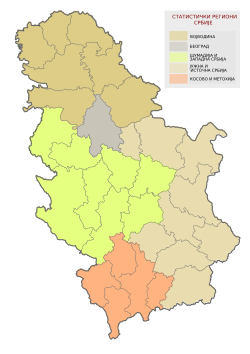| Southern and Eastern Serbia Јужна и источна Србија | |
|---|---|
| Statistical region of Serbia | |
 Location of Southern and Eastern Serbia Location of Southern and Eastern Serbia | |
| Country | |
| Founded | 2010 |
| Largest city | Niš |
| Area | |
| • Total | 26,245 km (10,133 sq mi) |
| • Rank | 2nd |
| Population | |
| • Total | 1,406,050 |
| • Rank | 4th |
| • Density | 54/km (140/sq mi) |
| GDP | |
| • Total | RSD 1,077.359 billion €9.172 billion (2022) |
| • Per capita | RSD 763,000 €6,496 (2022) |
| HDI | 0.797 (2019) high · 4th in Serbia |
The Southern and Eastern Serbia (Serbian: Јужна и источна Србија, romanized: Južna i istočna Srbija) is one of five statistical regions of Serbia. It is also a Level-2 statistical region according to the Nomenclature of Territorial Units for Statistics (NUTS).
History
In 2009, the National Assembly adopted a law which divided Serbia into seven statistical regions. At first, it was decided that in the territory of current statistical region of Southern and Eastern Serbia there would be two statistical regions – Eastern Region (Serbian: Источни регион, romanized: Istočni region) and Southern Region (Serbian: Јужни регион, romanized: Južni region). However, in 2010, the law was changed, thus the Eastern and Southern regions were merged into a single statistical region named Southern and Eastern Serbia.
Administrative districts
The statistical region of Southern and Eastern Serbia is composed of 9 administrative districts:
| District | Area (km) | Population (2022) | Seat |
|---|---|---|---|
| Podunavlje | 1,250 | 175,573 | Smederevo |
| Braničevo | 3,865 | 156,367 | Požarevac |
| Bor | 3,510 | 101,100 | Bor |
| Zaječar | 3,623 | 96,715 | Zaječar |
| Nišava | 2,727 | 343,950 | Niš |
| Pirot | 2,761 | 76,700 | Pirot |
| Toplica | 2,229 | 77,341 | Prokuplje |
| Jablanica | 2,770 | 184,502 | Leskovac |
| Pčinja | 3,520 | 193,802 | Vranje |
Demographics
The region is heavily affected by depopulation. Most critical situation is in municipalities of Gadžin Han, Crna Trava, Ražanj, Trgovište, Dimitrovgrad, and Bosilegrad. A stark example of depopulation is Crna Trava, which used to have 13,614 inhabitants in 1948, while in 2022 only 1,063 people were registered.
Cities and towns
The following list include cities and towns with over 20,000 inhabitants.
| City or town | Population (2022) |
|---|---|
| Niš | 182,797 |
| Smederevo | 59,261 |
| Leskovac | 58,338 |
| Vranje | 50,954 |
| Požarevac | 42,530 |
| Pirot | 34,942 |
| Zaječar | 32,448 |
| Bor | 28,822 |
| Prokuplje | 24,627 |
| Smederevska Palanka | 20,345 |
Ethnic structure
| Ethnicity | Population (2022) | Share |
|---|---|---|
| Serbs | 1,173,092 | 83.43% |
| Albanians | 58,145 | 4.14% |
| Romani people | 50,671 | 3.60% |
| Vlachs | 19,569 | 1.39% |
| Bulgarians | 10,554 | 0.75% |
| Undeclared | 20,495 | 1.46% |
| Unknown | 59,725 | 4.25% |
See also
References
- "Региони у Републици Србији" (pdf). stat.gov.rs (in Serbian). Statistical Office of Serbia. 16 October 2019. Retrieved 16 October 2019.
- "Први резултати Пописa становништва, домаћинстава и станова 2022". stat.gov.rs (in Serbian). Statistical Office of Serbia. 21 December 2022. Retrieved 21 December 2022.
- "REGIONAL GROSS DOMESTIC PRODUCT Regions and areas of the Republic of Serbia, 2023" (PDF).
- "Sub-national HDI - Area Database - Global Data Lab". hdi.globaldatalab.org. Retrieved 2021-07-19.
- "Uvedeno sedam statističkih regiona". B92.net (in Serbian). Retrieved 2021-03-02.
- "SANU: Jug Srbije sve prazniji, potrebne sistemske promene". Južne vesti. 25 March 2019.
- "Serbia: Regions, Districts and Major Cities – Population Statistics, Maps, Charts, Weather and Web Information".
- https://publikacije.stat.gov.rs/G2023/Pdf/G20234001.pdf
External links
| Statistical regions of Serbia | ||
|---|---|---|